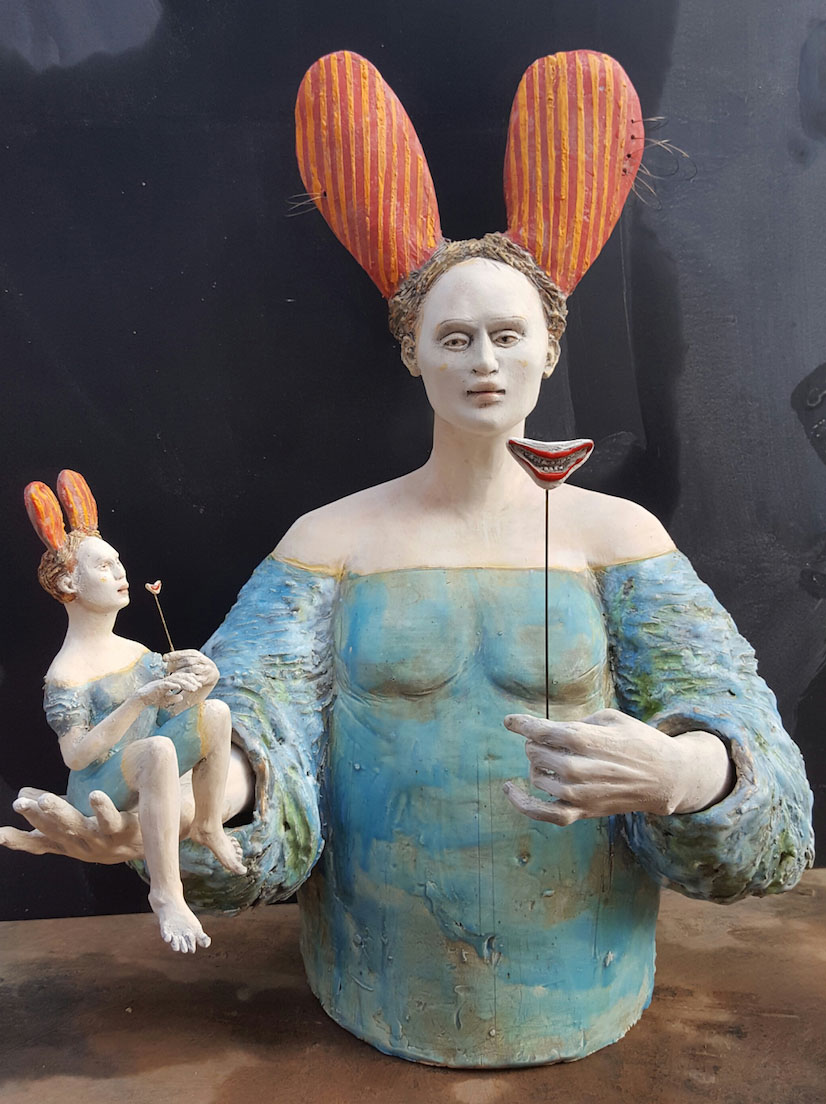
Left to right: Barbara Balzer, Les Diplomats (detail), 2017, Ceramic, 20 x 18 x 14 in., Linda Hall, Sometimes the Earth is Sky (detail), 2016, Fabric, 7 x 3 x 3 ft. Images courtesy of the artists.
Untethered, Stories Come Like Charms
Barbara Balzer and Linda Hall
Wasmer Art Gallery
October 12 - November 16, 2017
Sponsored by Gene and Lee Seidler, Renata and R.J. Vigoda, and Florida Department of State, Division of Cultural Affairs
Barbara Balzer

Barbara Balzer, Les Diplomats, 2017, Ceramic, 20 x 18 x 14 in. Courtesy of the artist
I use the human form to communicate ideas, suggest narratives, beguile, entertain, and entrance. My figures are silent ceramic responses to things heard, seen or read. My governing intent, as is any court jester’s, is to lure the viewer in long enough to allow the formulation of a response, whether a disapproving shake of the head or a smile as one walks away. Barbara, who has an MFA in Sculpture from Florida State University, has won many awards including the President de la Generalitat Valencariana First Place at the X Bienal Intenacional de Ceramica in Spain and was included in the Florida Museum of Women Artist Inaugural Exhibition. Most recently, the Macon Museum of Arts and Sciences purchased her work for inclusion in their permanent collection.
Linda Hall

Linda Hall, Animals Are in Us, 2015, Wall based assemblage, Dimensions variable. Courtesy of the artist.
Many of these pieces are what I consider containers. I am compelled to make, them but I ask myself “Containers for what? Spirit, contemplation, hope or loss?” They are sometimes and often simultaneously cast off and/or waiting to be filled. My latest works have been inspired by doubles. One body with two forces within it is the human condition. The opposing forces can manifest as a shadows, reflections or hidden truths made evident. With these works I am exploring balance and wholeness. Linda Hall is a multimedia artist inspired by the natural world and the human condition. She holds an MFA from the University of North Carolina at Chapel Hill. Her watercolors and three-dimensional soft sculptures have been exhibited in regional, national and international publications and venues. Her work has been featured on music CD covers, in New American Paintings and in the online editions of Oxford American and Beautiful Decay.
Call and Response: Artists, Audiences and the Construction of Meaning
by Anne Marie Bouche, Ph.D | FGCU Art History Faculty
As we enter this exhibition, we are like archaeologists uncovering the fragmentary remnants of a lost civilization. We look for clues we can recognize, patterns and categories that will help us find meaning in these works, a coherent framework or context in which to place them.
Humans are neurologically hard-wired to detect patterns and construct meaning. When we see representations of humans and animals, for example, we tend to see them as characters, and try to fit those characters into some sequential narrative or story. When we see inanimate objects, we try to attribute a function or meaning to the object. We respond viscerally to all the different material properties of physical objects, such as color, texture, space, and form.
Artists capitalize on this by using a variety of strategies designed to engage with fundamental human responses and behaviors.

Linda Hall, Sometimes the Earth is Sky (detail), 2016, Fabric, 7 x 3 x 3 ft. Courtesy of the artist.

Barbara Balzer, Golden Apprentice (detail), 2016, Ceramic, 20 x 21 x 17 in. Courtesy of the artist
One of these is our ability to identify physically with other physical objects - living
creatures, representations of living creatures, even inanimate things - though our
bodies. Our bodies detect and interpret forces like gravity, and stimuli like light,
and are able to intuit what other physical bodies are experiencing. This response,
known as “somatic identification” (“somatic” means “related to the body”) originally
evolved to help us detect danger and react appropriately to whatever we encounter.
When we see a human figure leaning at an extreme angle, we immediately feel its instability.
We are even able to estimate empirically how much “lean” is “too much” from our experience
of our own bodies. A figure that is in uncomfortable position – off-balance, upside
down, bent backwards at an angle that seems unnatural – causes us to sense (and evaluate)
its discomfort somatically, in our own bodies.
An object whose physical integrity is violated in some way elicits an empathetic somatic
response from us. Even a destroyed building or a broken piece of furniture affects
us psychologically, and this feeling is amplified when we perceive the damaged object
as potentially alive. This exhibition contains a number of sculptures that show human
and animal bodies manipulated in ways that suggest violation, distortion or disruption
of what is normal, and we respond emotionally to that.
Another way Balzer and Hall challenge us is with anomaly and enigma. Nothing in this
exhibition is quite natural. An animal head and a human head connected, like two masks
facing each other in conversation, an adult woman joined with (or giving birth to?)
another adult woman, a human head sprouting the horns of a goat, a woman and an owl
who are the same size, sitting together on a pillow — these do not normally exist
in the natural world. Such anomalies set off a silent warning bell that attracts our
attention and creates a slight sense of curiosity and discomfort. Once that is activated,
we are driven to seek an explanation that would help us situate the objects in some
rational (if possibly supernatural or fictional) context.
Anomalies are like deliberate puzzles – they are inherently provoking, engaging our
attention and raising questions.

Barbara Balzer, Narcissus and Echo, Lovers, 2014, Ceramic, 31 x 21 x 26 in. Courtesy of the artist.
Linda Hall’s pairs of linked creatures, for example, have parallels in the imagery of pre-Columbian cultures, and they also suggest masks. In some of her sculptures she uses techniques (stitching) and materials (repurposed fabrics) that reference traditional women’s crafts from our own recent historical past.
In the works that are assembled from old clothing and fabric scraps, each individual scrap or clothing piece comes with its own individual past, so that we both see the works as a whole, and contemplate the individual stories of each of the parts. We are made aware of the process by which each finished object was created. The patchwork method used to assemble these works, and the evident age and wear of some of the materials, remind us that they are in some sense the survivors of past lived experiences, like the battered dolls found in attics. Barbara Balzer’s works, with their horned heads and fetishistic use of objects, suggest parallels with myth, legend, dream imagery, and, in their slightly surreal style, with effigies and carnival costumes. Some are consciously based on historical works of art — for example, the woman and owl seated on the pillow (including the disparity of scale in that work) are derived from Hieronymous Bosch’s triptych, The Garden of Earthly Delights, ca. 1500 (Prado Museum).
The works exhibited here together are also self-referential – that is, the artists
re-use some of the same motifs in more than one work. An example is the repeated appearance
of the pillow motif in Balzer’s sculptures. Seen once, the pillow might pass as an
incidental prop. Seen more than once in different sculptures, it becomes obvious that
the motif has some clearly symbolic importance. The artist has explained the meaning
it has for her — the pillow suggests sleep, so a dream state.
Ultimately, these objects live in two realms. They remain personal to the artists,
mysterious and deliberately allusive and open-ended in their imagery. But they also
become part of us, when we attribute meaning to them by trying to locate them in a
broader context informed by our own experiences and sensations. We register how they
influence our feelings and evoke ideas in us, but we cannot pin them down with any
one definitive explanation.
That is surely deliberate — the goal is to engage the viewer in an extended dialogue
and interaction by stimulating an interpretative process. The longer the “answer”
remains elusive, the more likely it is that a viewer will remain in the conversation
and derive pleasure and interest from the experience. Barbara Balzer and Linda Hall
activate our interpretative responses, but they don’t provide any simplistic answers
that would make it easy for us to fully satisfy our curiosity.

Linda Hall, The Moon and Raven, 2014, Fabric, 3 x 4.5 x 2 ft. Courtesy of the artist.
